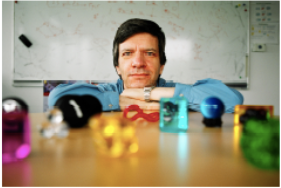Plenary Speakers
- Luca Cardelli, Microsoft Research Morphisms of reaction networks
|
Friday 4th September 15:00 -- 16:00 Luca Cardelli is a Principal Researcher at Microsoft Research Cambridge. He heads Programming Principles and Tools Group and his main interests are in type theory and operational semantics, mostly for applications to language design and distributed computing. More... |  |
Abstract
The mechanisms underlying complex biological systems are routinely represented as networks. Network kinetics is widely studied, and so is the connection between network structure and behavior. But it is the relationships between network structures that can reveal similarity of mechanism.
We define morphisms (mappings) between reaction networks that establish structural connections between them. Some morphisms imply kinetic similarity, and yet their properties can be checked statically on the structure of the networks. In particular we can determine statically that a complex network will emulate a simpler network: it will reproduce its kinetics for all corresponding choices of reaction rates and initial conditions. We use this property to relate the kinetics of many common biological networks of different sizes, also relating them to a fundamental population algorithm. Thus, structural similarity between reaction networks can be revealed by network morphisms, elucidating mechanistic and functional aspects of complex networks in terms of simpler networks
In recent joint work, we established a correspondence between network emulation and a notion of backward
bisimulation for continuous systems. An emulation morphism establishes a bisimulation relation over the union of
two networks, and a bisimulation relation over a network can be seen as an emulation morphism from the full
network to the reduced network of its equivalence classes. Along this correspondence, we obtain minimization
algorithms for chemical reaction networks, which are of interest for model execution, and algorithms to discover
morphisms between networks, which are of interest for model understanding. [With Mirco Tribastone, Max
Tschaikowski, Andrea Vandin.]
- Mustafa Khammash, ETH Zurich Cybergenetics: Synthetic Circuits and Systems for the Precise Control of Living Cells
|
Saturday 5th September 9:30 -- 10:30 Mustafa Khammash is the Professor of Control Theory and Systems Biology at the Department of Biosystems Science and Engineering (D-BSSE) at ETH Zurich, and is currently serving as the head of the department. He works at the interface of systems biology, synthetic biology, and control theory, focusing on development of novel computational methods for the modeling, simulation, analysis, and control of biological networks. More... |  |
Abstract
Norbert Wiener’s 1948 Cybernetics presented a vision unifying the study of control and communication in the animal and the machine. Predating the discovery of the structure of DNA and the ensuing molecular biology revolution, applications in the life sciences at the time were limited. More than 60 years later, the confluence of modern genetic manipulation techniques, powerful measurement technologies, and advanced analysis methods is enabling a new area of research in which systems and control notions are used for regulating cellular processes at the gene level. This presentation describes new experimental and analytical work on the design and analysis of control systems for the precise control of living cells. Using computer control coupled with optogenetic and flow cytometry technologies, we show that automated feedback loops can achieve precise and extremely robust control of gene expression in living cells. We then demonstrate that molecular control systems can be realized entirely inside living cells and then used to achieve autonomous regulation of gene expression. Finally, we present a new control theory for the integral control of gene expression in a stochastic setting. We show that such stochastic integral control utilizes just a few molecules to achieve robust steady-state tracking and perfect adaptation and, remarkably, that it leads to closed-loop systems that are more robust than their deterministic counterparts.

